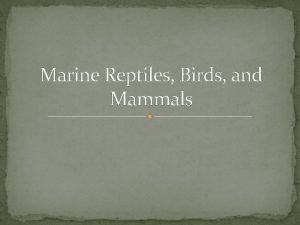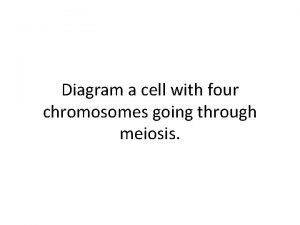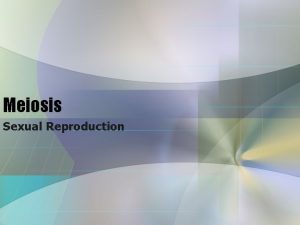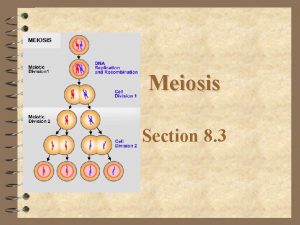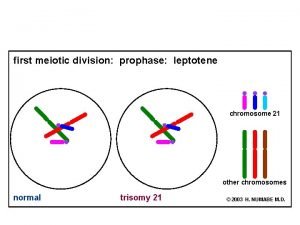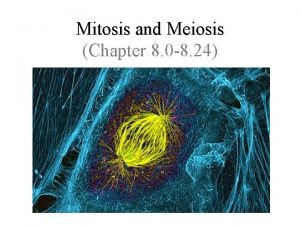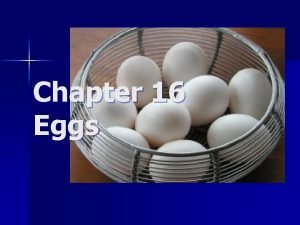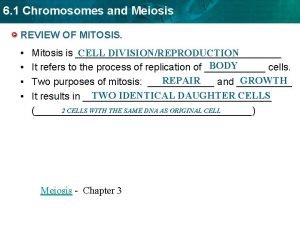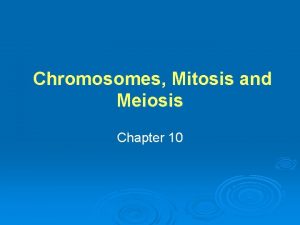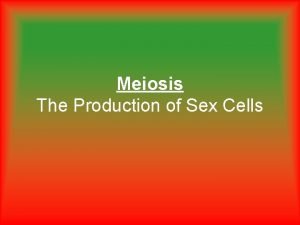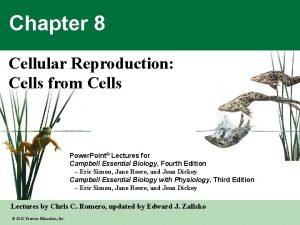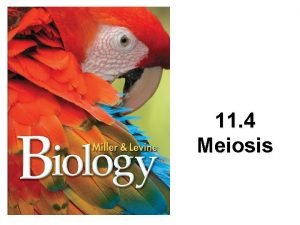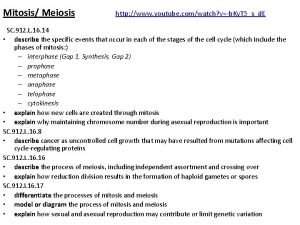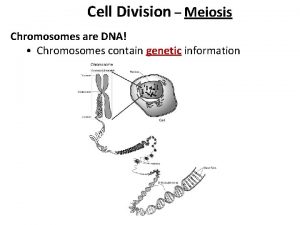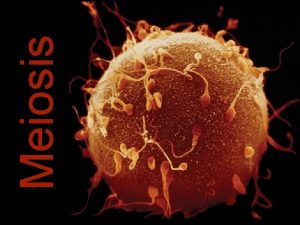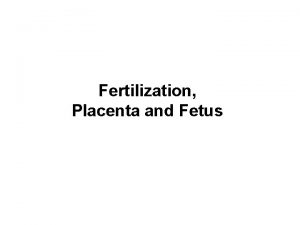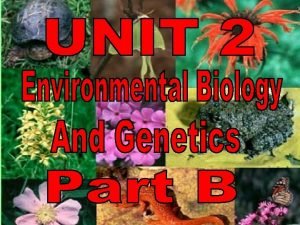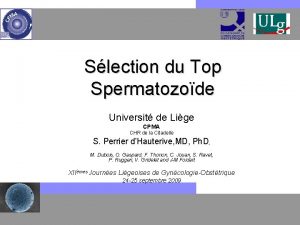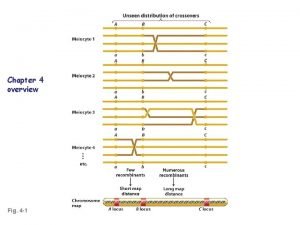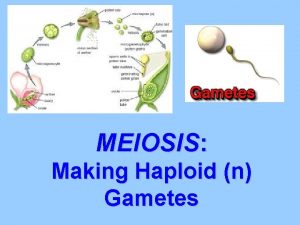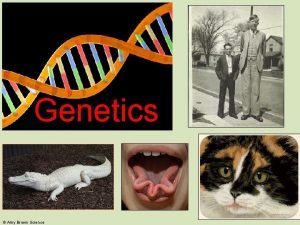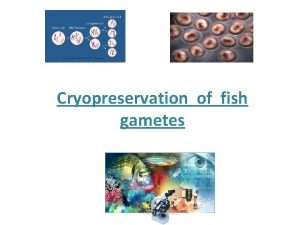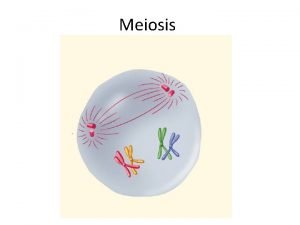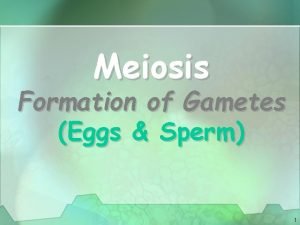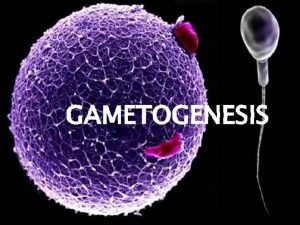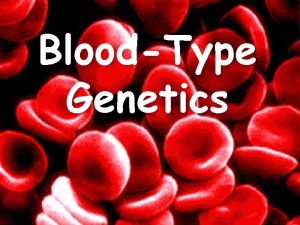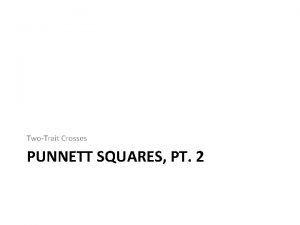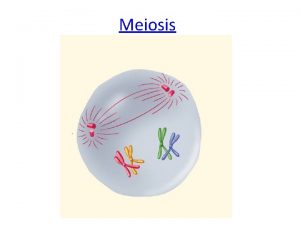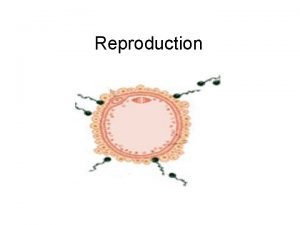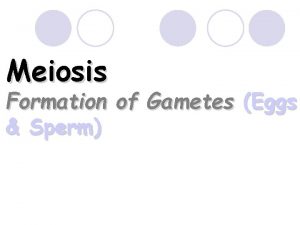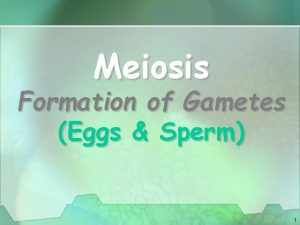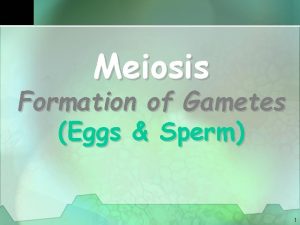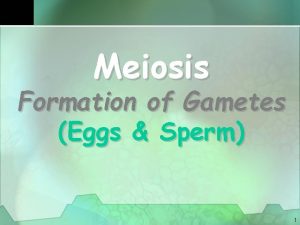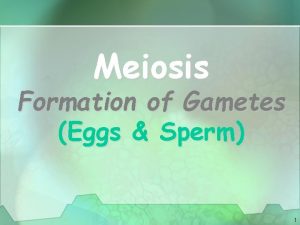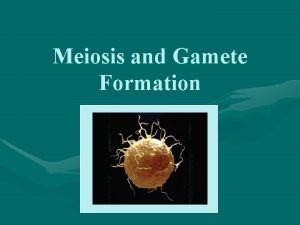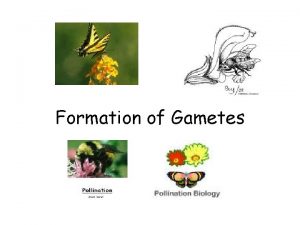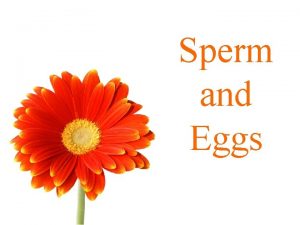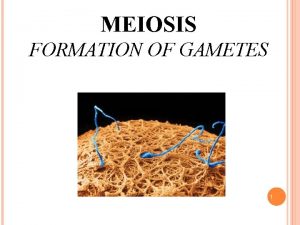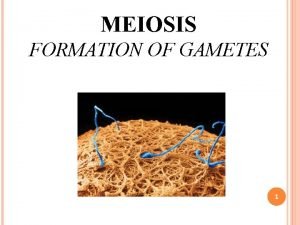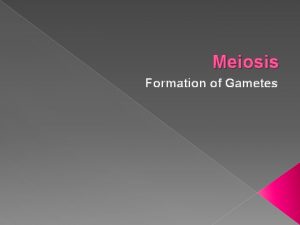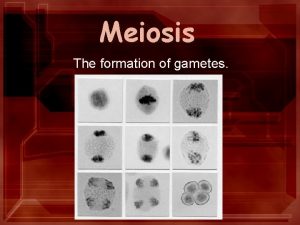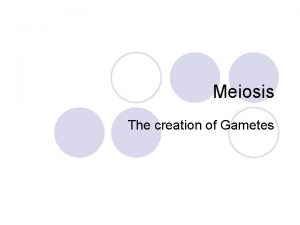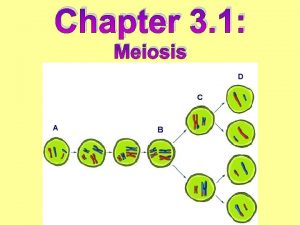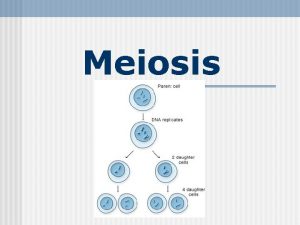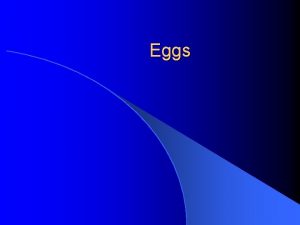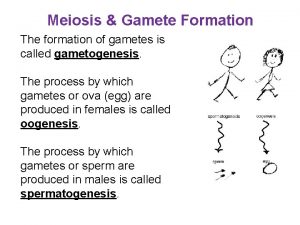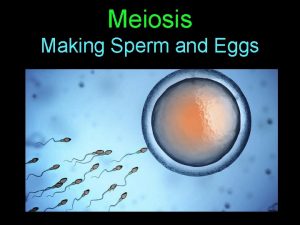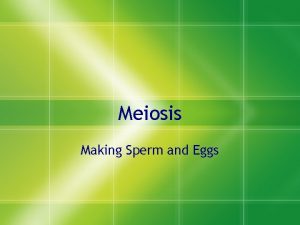Meiosis Formation of Gametes Eggs Sperm 1 Chromosomes












































- Slides: 44

Meiosis Formation of Gametes (Eggs & Sperm) 1

Chromosomes 2

Eukaryotic Chromosomes üAll eukaryotic information in cells store genetic chromosomes ü Most eukaryotes have between 10 and 50 chromosomes in their body cells ü Human body cells have 46 chromosomes or 23 identical pairs 3

Eukaryotic Chromosomes üEach chromosome is composed of a single, tightly coiled DNA molecule üChromosomes can’t be seen when cells aren’t dividing and are called chromatin 4

Chromosomes in Dividing Cells üDuplicated chromosomes are called chromatids & are held together by the centromere Called Sister Chromatids 5

Karyotype ü A picture of the chromosomes from a human cell arranged in pairs by size ü First 22 pairs are called autosomes ü Last pair are the sex chromosomes ü XX female or XY male 6

Boy or Girl? The Y Chromosome Decides Y - Chromosome X - Chromosome 7

Facts About Meiosis üPreceded by interphase which includes chromosome replication üTwo meiotic divisions --- Meiosis I and Meiosis II üCalled Reduction- division üOriginal cell is diploid (2 n) üFour daughter cells produced that are monoploid (1 n) 8

Facts About Meiosis üDaughter cells contain half the number of chromosomes as the original cell üProduces gametes (eggs & sperm) üOccurs in the testes in males (Spermatogenesis) üOccurs in the ovaries in females (Oogenesis) 9

More Meiosis Facts ü Start with 46 double stranded chromosomes (2 n) üAfter 1 division - 23 double stranded chromosomes (n) üAfter 2 nd division - 23 single stranded chromosomes (n) ü Occurs in our germ cells that produce gametes 10

Why Do we Need Meiosis? üIt is the fundamental basis of sexual reproduction üTwo haploid (1 n) gametes are brought together through fertilization to form a diploid (2 n) zygote 11

Fertilization – “Putting it all together” 2 n = 6 1 n =3 12

Replication of Chromosomes ü Replication is the process of duplicating a chromosome ü Occurs prior to division ü Replicated copies are called sister chromatids ü Held together at centromere Occurs in Interphase 13

A Replicated Chromosome Gene X Homologs (same genes, different alleles) Sister Chromatids (same genes, same alleles) Homologs separate in meiosis I and therefore different alleles separate. 14

Meiosis Forms Haploid Gametes ü Meiosis must reduce the chromosome number by half ü Fertilization then restores the 2 n number from mom from dad child too much! meiosis reduces genetic content The right number! 15

Meiosis: Two Part Cell Division Sister chromatids separate Homologs separate Meiosis II Diploid Haploid 16

Meiosis I: Reduction Division Nucleus Early Late Prophase I (Chromosome Prophase I number doubled) Spindle fibers Nuclear envelope Metaphase Anaphase Telophase I I I (diploid) 17

Prophase I Early prophase üHomologs pair. üCrossing over occurs. Late prophase üChromosomes condense. üSpindle forms. üNuclear envelope fragments. 18

Tetrads Form in Prophase I Homologous chromosomes (each with sister chromatids) Join to form a TETRAD Called Synapsis 19

Crossing-Over ü Homologous chromosomes in a tetrad cross over each other ü Pieces of chromosomes or genes are exchanged ü Produces Genetic recombination in the offspring 20

Homologous Chromosomes During Crossing-Over 21

Crossing-Over Crossing-over multiplies the already huge number of different gamete types produced by independent assortment 22

Metaphase I Homologous pairs of chromosomes align along the equator of the cell 23

Anaphase I Homologs separate and move to opposite poles. Sister chromatids remain attached at their centromeres. 24

Telophase I Nuclear envelopes reassemble. Spindle disappears. Cytokinesis divides cell into two. 25

Meiosis II Gene X Only one homolog of each chromosome is present in the cell Sister chromatids carry identical genetic information. Meiosis II produces gametes with one copy of each chromosome and thus one copy of each gene. 26

Meiosis II: Reducing Chromosome Number Prophase Metaphase II Telophase II Anaphase 4 Identical II II haploid cells 27

Prophase II Nuclear envelope fragments. Spindle forms. 28

Metaphase II Chromosomes align along equator of cell. 29

Anaphase II Equator Pole Sister chromatids separate and move to opposite poles. 30

Telophase II Nuclear envelope assembles. Chromosomes decondense. Spindle disappears. Cytokinesis divides cell into two. 31

Results of Meiosis Gametes (egg & sperm) form Four haploid cells with one copy of each chromosome One allele of each gene Different combinations of alleles for different genes along the chromosome 32

Gametogenesis Oogenesis or Spermatogenesis 33

Spermatogenesis ü Occurs in the testes ü Two divisions produce 4 spermatids ü Spermatids mature into sperm ü Men produce about 250, 000 sperm per day 34

Spermatogenesis in the Testes Spermatid 35

Spermatogenesis 36

Oogenesis üOccurs in the ovaries üTwo divisions produce 3 polar bodies that die and 1 egg üPolar bodies die because of unequal division of cytoplasm üImmature egg called oocyte üStarting at puberty, one oocyte matures into an ovum (egg) every 28 days 37

Oogenesis in the Ovaries 38

Oogenesis First polar body may divide (haploid) a Mitosis Oogonium (diploid) X A X Primary oocyte (diploid) X a a Polar bodies die X Meiosis II (if fertilization A occurs) X A X Secondary oocyte (haploid) Ovum (egg) Mature egg A X Second polar body (haploid) 39

Comparing Mitosis and Meiosis 40

Comparison of Divisions Mitosis Number of divisions Number of daughter cells Genetically identical? 1 Meiosis 2 2 4 Yes No Same as parent Half of parent Where Somatic cells Germ cells When Throughout life At sexual maturity Growth and repair Sexual reproduction Chromosome # Role 41

Chromosomal Structure Mutations when pieces of chromosomes are "broken" off, have other pieces added on or moved around; sometimes can be very harmful, but depends on the number and type of genes that are affected 42

NONDISJUCTION of Chromosomes When the chromosomes do not split during the process of meiosis, it is called NONDISJUNCTION. In this case, gametes can have more or less than the n number of chromosomes. In trisomy there is an extra chromosome. In monosomy the is a single chromosome without a pair 43

NONDISJUCTION of Chromosomes If an entire set of chromosomes fail to separate, you have a polyploid organism (where the chromosome number is 3 n or 4 n instead of the diploid 2 n condition Polyploidy is common in plants, an example is the plump strawberries. In animals, polyploidy is usually lethal: this is because so many genes are affected, and animals are much more complex than plants 44
 Why are sperm whales called sperm whales
Why are sperm whales called sperm whales Cell with four chromosomes
Cell with four chromosomes Meiosis square dance
Meiosis square dance Meiosis reproduction
Meiosis reproduction Leptotene
Leptotene Meiosis makes gametes
Meiosis makes gametes Chapter 17 eggs selecting and storing eggs
Chapter 17 eggs selecting and storing eggs Chromosomes number is maintained mitosis or meiosis
Chromosomes number is maintained mitosis or meiosis Non kinetochore microtubules
Non kinetochore microtubules Number of chromosomes in meiosis
Number of chromosomes in meiosis Meiosis homologous chromosomes
Meiosis homologous chromosomes Miller and levine biology textbook
Miller and levine biology textbook Number of chromosomes in meiosis
Number of chromosomes in meiosis Independent assortment of chromosomes
Independent assortment of chromosomes Where does cell mitosis occur in skin
Where does cell mitosis occur in skin What does mitosis make
What does mitosis make Meiosis 1 and 2
Meiosis 1 and 2 Disvantages of sexual reproduction
Disvantages of sexual reproduction Chapter 10 section 1: meiosis
Chapter 10 section 1: meiosis Meiosis and genetic variation answer key
Meiosis and genetic variation answer key Image of prophase 2
Image of prophase 2 Differentiate between chromosome and chromatid
Differentiate between chromosome and chromatid Chapter 10 section 1: meiosis
Chapter 10 section 1: meiosis Gametes
Gametes Epididimis berfungsi
Epididimis berfungsi Spermatozode
Spermatozode Describe gametes
Describe gametes Gametes
Gametes Dihybrid
Dihybrid Urinary system interesting facts
Urinary system interesting facts Gametes
Gametes How are somatic cells different from gametes
How are somatic cells different from gametes Roan coat cow
Roan coat cow Foil method gametes
Foil method gametes Cryopreservation of fish gametes
Cryopreservation of fish gametes Process of gametes
Process of gametes Gametes definition
Gametes definition Gametogenesis definition
Gametogenesis definition B+ blood type ethnicity
B+ blood type ethnicity Two traits punnett square
Two traits punnett square Prophase 1
Prophase 1 Dihybrid cross using foil method
Dihybrid cross using foil method How to do dihybrid crosses
How to do dihybrid crosses Formation initiale vs formation continue
Formation initiale vs formation continue What are gonads?
What are gonads?
